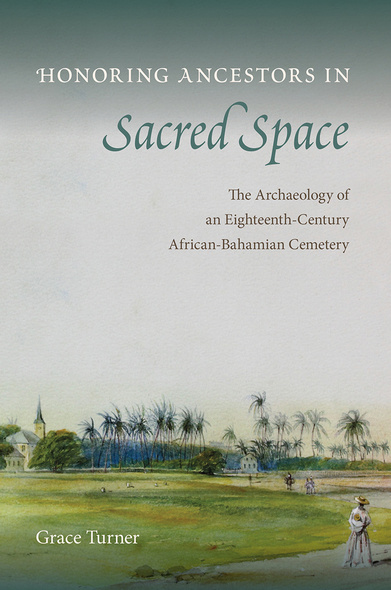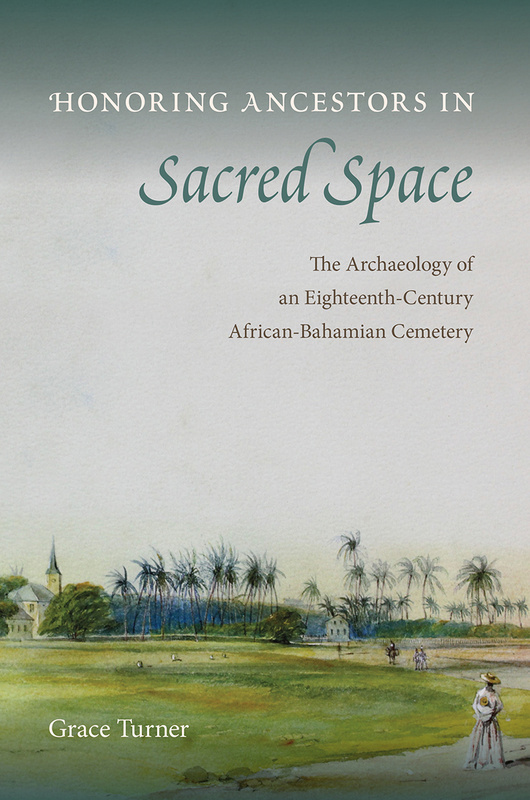
Honoring Ancestors in Sacred Space
The Archaeology of an Eighteenth-Century African-Bahamian Cemetery
The Anglican Church established St. Matthew’s Parish on the eastern side of Nassau to accommodate a population increase after British Loyalists migrated to the Bahamas in the 1780s. The parish had three separate cemeteries: the churchyard cemetery and Centre Burial Ground were for whites, but the Northern Burial Ground was officially consecrated for nonwhites in 1826 by the Bishop of Jamaica. In Honoring Ancestors in Sacred Space, Grace Turner posits that the African-Bahamian community intentionally established this separate cemetery in order to observe non-European burial customs. Analyzing the landscape and artifacts found at the site, Turner shows how the community used this space to maintain a sense of social and cultural belonging despite the power of white planters and the colonial government.
Although the Northern Burial Ground was covered by storm surges in the 1920s, and later a sidewalk was built through the site, Turner’s fieldwork reveals a wealth of material culture. She points to the cemetery’s location near water, trees planted at the heads of graves, personal items left with the dead, and remnants of food offerings as evidence of mortuary practices originating in West and Central Africa. According to Turner, these African-influenced ways of memorializing the dead illustrate W. E. B. Du Bois’s idea of “double consciousness”—the experience of existing in two irreconcilable cultures at the same time. Comparing the burial ground with others in Great Britain and the American colonies, Turner demonstrates how Africans in the Atlantic diaspora did not always adopt European customs but often created a separate, parallel world for themselves.
A volume in the Florida Museum of Natural History: Ripley P. Bullen Series
“A fascinating study. . . . Contributes significantly to our understanding of African-derived cultural practices in the Americas and especially in the Bahamas.”—Latin American Antiquity
“Adds a welcome Caribbean voice to a chorus of valuable works contributed primarily by North Americans working in Antillean contexts. . . . A refreshing contribution.”—Historical Archaeology
“A meaningful contribution to a growing body of research on the archaeology of the African diaspora that moves from the plantation to the urban center and calls attention to the variability of experiences that existed historically within communities of African descent. . . . Turner is an important Bahamian archaeological voice.”—Journal of Anthropological Research
“Ground-breaking on multiple levels. . . . Throughout these chapters, it is clear that island residents were involved at every step. . . . Turner’s work should be referenced by anyone working in such burial grounds in the Caribbean or in the southern United States. . . . It is public archaeology and anthropology at its best.”—Journal of the Royal Anthropological Institute
“A rare example of descendant communities researching, investigating, and writing about their own past from an anti-colonial and anti-racist perspective.”—Southeastern Archaeology
“Provides new insights into how enslaved and freed Africans in the New World navigated racialized landscapes while honoring the memories of their dead.”—Laurie A. Wilkie, coauthor of Sampling Many Pots: An Archaeology of Memory and Tradition at a Bahamian Plantation“Turner’s unique hybrid approach makes this book a valuable resource in the study of the African diaspora.”—Rosalyn Howard, author of Black Seminoles in the Bahamas
Grace Turner is chief archaeologist at the Antiquities, Monuments & Museum Corporation in Nassau, Bahamas.




